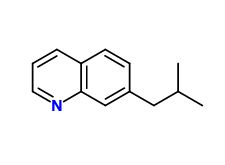
Photo credits: ScenTree SAS
| Company | Ingredient Name | ID | Comments | Naturality | Certifications | Purity | Latin name | Treated part | Geographical origin | MOQ |
|---|---|---|---|---|---|---|---|---|---|---|
|
|
Isobutyl Quinoleine - 30 Gr | - |
Visit website
|
- | - | - | - | - | - |
General Presentation
-
CAS N° : 68198-80-1
-
EINECS number : 269-204-7
-
FEMA number : Donnée indisponible.
-
FLAVIS number : Donnée indisponible.
-
JECFA number : Donnée indisponible.
-
Appearance : Colorless liquid
-
Density : 1,011
-
Volatility : Base
-
Price Range : €€€
Physico-chemical properties
-
Molecular formula : C13H15N
-
Molecular Weight : 185,27 g/mol
-
Log P : 4,09
-
Fusion Point : Donnée indisponible.
-
Boiling Point :
-
Detection Threshold : Donnée indisponible.
-
Optical rotation : Donnée indisponible
-
Vapor pressure : Donnée indisponible
-
Refractive Index @20°C : Donnée indisponible
-
Acid Value : Donnée indisponible.
-
Flash Point : 137°C
Uses
Uses in perfumery :
IsoButyl Quinoline is used for chypre and leather notes, for a contribution of character and power. Gives character to floral accords when used in small quantity.
Year of discovery :
1908
Natural availability :
IsoButyl Quinoline is not available in its natural state.
Isomerism :
Butyl Quinoline is a positional isomer of Isobutyl Quinoline, but is very little used in perfumery.
Synthesis precursor :
IsoButyl Quinoline is not a precursor to the synthesis of another compound of olfactory interest.
Synthesis route :
IsoButyl Quinoline is synthesized by a sequence of reactions called Skraup synthesis, reacting para-Isobutylaniline with glycerol in the presence of a concentrated sulfuric acid and nitrobenzene afterwards. This synthetic route is used for the synthesis of all quinolines.
Regulations & IFRA
Allergens :
This ingredient does not contain any allergen.
IFRA 51th :
This ingredient is not restricted for the 51th amendment


